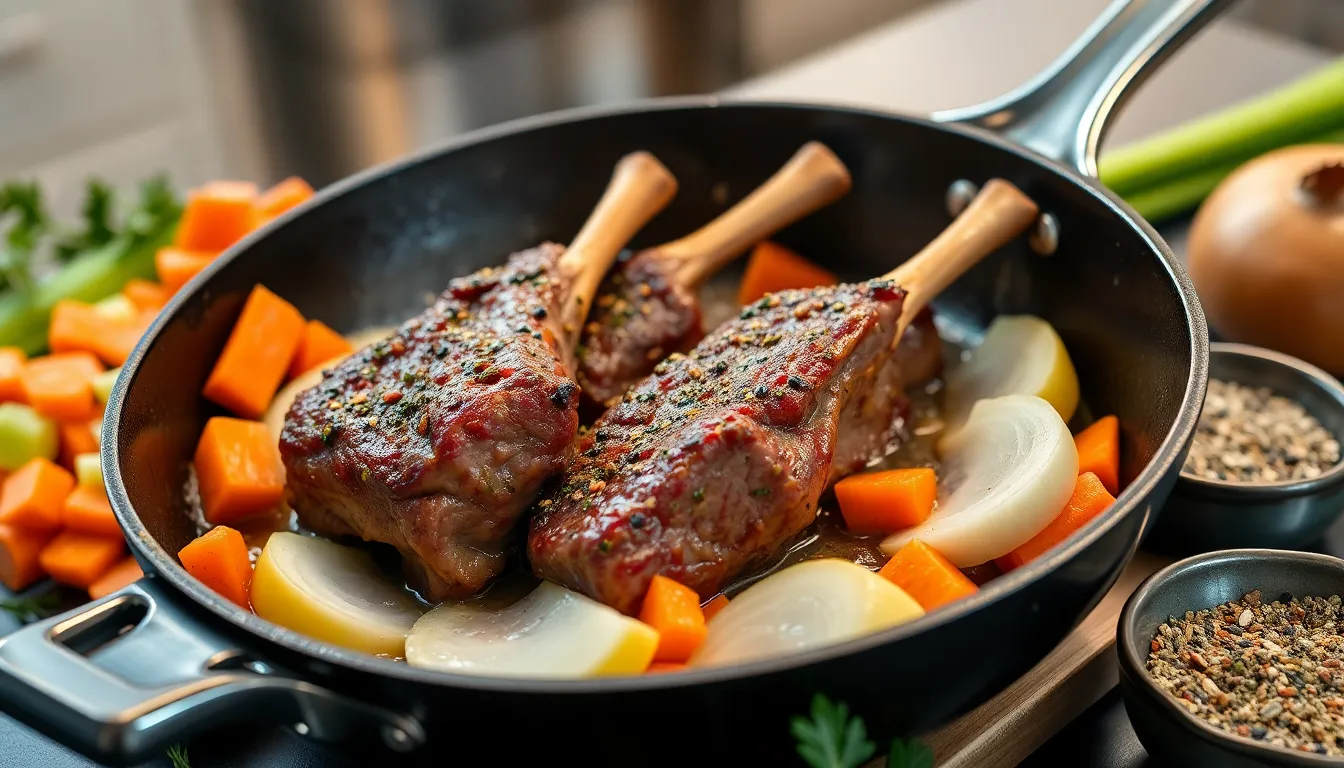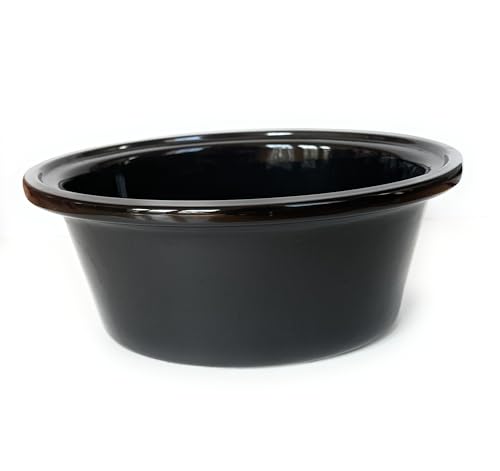Transform tough beef shank into tender, fall-off-the-bone perfection with our foolproof crockpot method. We’ve discovered that this often-overlooked cut becomes incredibly succulent when slow-cooked, developing rich flavors that’ll make your kitchen smell absolutely divine.
Beef shank might seem intimidating, but we’re here to show you how simple it really is. This budget-friendly cut contains natural collagen that breaks down during the long, slow cooking process, creating a silky, restaurant-quality sauce that coats every bite. We love how the crockpot does all the heavy lifting while we go about our day.
Our slow cooker beef shank recipe delivers maximum flavor with minimal effort. You’ll get tender meat that shreds easily, paired with vegetables that have absorbed all those incredible savory juices. It’s comfort food at its finest – perfect for busy weeknights or lazy Sunday dinners when you want something special without the fuss.
Ingredients
We’ve carefully selected each ingredient to enhance the natural flavors of the beef shank while creating a rich and satisfying meal. Our ingredient list focuses on simple pantry staples that work together to create depth and complexity in the slow cooker.
For the Beef Shanks
- 3 to 4 pounds beef shanks, cut into 2-inch thick rounds
- 2 tablespoons olive oil for browning
- 1 teaspoon kosher salt
- 1/2 teaspoon black pepper
For the Vegetables
- 1 large yellow onion, diced into 1-inch pieces
- 4 medium carrots, peeled and cut into 2-inch chunks
- 3 celery stalks, chopped into 1-inch pieces
- 4 cloves garlic, minced
- 8 ounces baby potatoes, halved (optional)
- 2 bay leaves
For the Seasoning and Sauce
- 2 cups beef broth, low sodium preferred
- 1 cup red wine (Cabernet Sauvignon or Merlot work well)
- 2 tablespoons tomato paste
- 1 tablespoon Worcestershire sauce
- 1 teaspoon dried thyme
- 1 teaspoon dried rosemary
- 1/2 teaspoon smoked paprika
- 2 tablespoons cornstarch mixed with 2 tablespoons cold water (for thickening)
- Fresh parsley for garnish
Equipment Needed

Having the right tools makes our beef shank crockpot recipe both efficient and successful. We recommend gathering these essential items before starting the cooking process.
Primary Cooking Equipment:
- 6-quart crockpot or slow cooker (handles 3-4 pounds of beef shanks comfortably)
- Heavy-bottomed skillet or frying pan for searing
- Medium saucepan for sauce reduction
Preparation Tools:
- Small mixing bowl for seasoning blend
- Measuring cups and spoons
- Sharp knife for vegetable prep
- Cutting board
Optional Enhancement Equipment:
- Rimmed baking sheet with aluminum foil (for optional broiling step)
- Kitchen tongs for safe meat handling
- Fine-mesh strainer for cooking liquid
- Whisk for thickening sauce
- Large spoon for fat removal
The 6-quart capacity crockpot ensures adequate space for proper heat circulation around the beef shanks. Our recommended skillet allows for optimal searing results that develop rich flavors before slow cooking begins.
| Equipment Type | Essential | Optional |
|---|---|---|
| Crockpot/Slow Cooker | ✓ | |
| Skillet | ✓ | |
| Small Bowl | ✓ | |
| Measuring Tools | ✓ | |
| Baking Sheet | ✓ | |
| Kitchen Tongs | ✓ | |
| Fine Strainer | ✓ |
We find that having all equipment ready before cooking starts streamlines the entire process and prevents any mid-recipe scrambling for tools.
Prep Instructions

Proper preparation sets the foundation for our tender and flavorful crockpot beef shank dish. We’ll walk through each essential step to ensure maximum flavor development and cooking success.
Preparing the Beef Shanks
We begin by selecting bone-in beef shanks weighing approximately 2 to 2.5 pounds total for four generous servings. Season the shanks generously with salt and pepper on all surfaces. Create our herb mixture by combining dried rosemary, thyme, garlic powder, and onion powder in equal portions.
For enhanced flavor depth, we recommend dredging the seasoned shanks in flour mixed with additional spices. Combine all-purpose flour with garlic powder, onion powder, smoked paprika, rosemary, and thyme in a shallow dish. This coating step adds richness while helping thicken our braising liquid during cooking.
Heat oil in a heavy-bottomed skillet over medium-high heat. Sear each beef shank for 2 to 3 minutes per side until golden brown develops on all surfaces. This browning step creates essential flavor compounds through the Maillard reaction, building our dish’s complex taste profile.
Chopping the Vegetables
Our vegetable preparation focuses on uniform cuts for even cooking throughout the slow braising process. Peel and slice carrots into 1-inch diagonal pieces to maintain their shape during extended cooking. Cut celery stalks into similar-sized pieces, maintaining consistency with our carrot preparation.
Chop onions into large wedges rather than small dice to prevent them from breaking down completely during the long cooking time. Halve baby potatoes if using them immediately, though we recommend adding these vegetables during the final 4 hours of cooking to prevent overcooking.
Mince garlic cloves finely or crush them with the flat side of our knife blade. Open canned fire-roasted stewed tomatoes and drain the liquid into a separate container, reserving both components for different stages of our cooking process.
Making the Seasoning Mix
We create our signature seasoning blend by combining exact measurements for optimal flavor balance. Mix 1 teaspoon each of garlic powder, onion powder, dried rosemary, and dried thyme in a small bowl. Add 1/2 teaspoon of smoked paprika along with salt and freshly ground black pepper to taste.
This seasoning mixture serves multiple purposes throughout our cooking process. We use portions for coating our beef shanks before searing and reserve the remainder for seasoning our braising liquid. The blend creates consistent flavor distribution while the smoked paprika adds subtle depth without overpowering the beef’s natural taste.
Prepare our braising liquid by combining 3 cups of quality beef broth with 2 tablespoons of Worcestershire sauce. This liquid base will transform into a rich, concentrated sauce as it slowly reduces around our beef shanks during the extended cooking period.
Crockpot Instructions

Now that we’ve prepared our ingredients and equipment, we’re ready to transform our beef shanks into a mouthwatering meal. The crockpot cooking process involves three key phases that ensure perfect results every time.
Initial Setup
We start by placing our seasoned beef shanks in the preheated heavy-bottomed skillet over medium-high heat. Heat 2 tablespoons of olive oil until it shimmers, then carefully place the flour-coated shanks in the pan without overcrowding. Sear each shank for 4-5 minutes per side until a golden brown crust forms on all surfaces.
Transfer the beautifully seared shanks to our greased 6-quart crockpot, arranging them in a single layer. Return the same skillet to medium heat and add our prepared vegetables—onions, carrots, and celery. Sauté these aromatics for 3-4 minutes until they begin to soften and release their natural flavors.
Add the minced garlic to the vegetables and cook for another minute until fragrant. Pour in our beef broth mixture, scraping up any browned bits from the bottom of the pan with a wooden spoon. These caramelized pieces add incredible depth to our braising liquid.
Pour the hot broth and vegetable mixture over the beef shanks in the crockpot. Add our baby potatoes around the meat, ensuring they’re nestled into the liquid. Sprinkle our signature herb blend over everything, then add the bay leaves for additional aromatic complexity.
Slow Cooking Process
We set our crockpot to the low heat setting for optimal tenderness. The beef shanks require 8 hours of gentle cooking to break down the tough connective tissues properly. This low and slow approach allows the collagen to transform into rich gelatin, creating that signature silky sauce we’re after.
| Cooking Method | Temperature | Time Duration | Result Quality |
|---|---|---|---|
| Low Heat | 200°F | 8 hours | Maximum tenderness |
| High Heat | 300°F | 4-5 hours | Good but less tender |
Resist the temptation to lift the lid during cooking, as this releases valuable steam and extends the cooking time. Our crockpot creates the perfect sealed environment for the meat to braise in its own juices. The only exception is a quick check at the 6-hour mark if we’re concerned about liquid levels.
Add root vegetables like turnips or parsnips during the final 2 hours if desired. These heartier vegetables won’t become mushy with the shorter cooking time. Fresh herbs should wait until the last 30 minutes to maintain their bright flavors.
Checking for Doneness
We know our beef shanks are perfectly cooked when the meat easily separates from the bone with gentle pressure from a fork. The internal temperature should reach 195°F to 205°F for optimal tenderness. At this temperature, the tough collagen has completely broken down into succulent gelatin.
Carefully remove one shank with kitchen tongs and test the texture. The meat should practically fall off the bone while still maintaining some structure. If the shanks need more time, continue cooking in 30-minute intervals until they reach the desired tenderness.
Strain the cooking liquid through a fine-mesh sieve into our medium saucepan for sauce reduction. Bring the liquid to a gentle simmer over medium heat and reduce by half, creating a glossy, concentrated sauce. This process takes approximately 10-15 minutes and intensifies all the flavors we’ve built throughout the cooking process.
For an optional finishing touch, we can place the cooked shanks under the broiler for 2-3 minutes to crisp the exterior fat slightly. This creates a delightful textural contrast while maintaining the tender interior we’ve worked so hard to achieve.
Serving Suggestions

After hours of slow cooking, our tender beef shanks deserve accompaniments that complement their rich, deeply concentrated flavors. We recommend pairing this hearty dish with sides that can absorb the luxurious braising liquid while adding textural contrast.
Side Dish Pairings
Creamy mashed potatoes stand as our top recommendation for serving alongside beef shanks. The smooth, buttery texture creates the perfect canvas for soaking up the rich braising sauce. Garlic mashed cauliflower offers a lighter alternative while maintaining that creamy consistency we love.
For an authentic Italian approach, we suggest polenta or risotto as traditional pairings that complement the beef’s robust flavors. These creamy grain dishes absorb the cooking liquid beautifully while adding their own subtle flavors to each bite.
Crusty breads play an essential role in our serving strategy. We recommend no-knead country bread or cheddar dill bread for mopping up every drop of the flavorful sauce. The contrast between the bread’s crispy exterior and soft interior enhances the overall dining experience.
Roasted or steamed vegetables provide color and nutritional balance to the plate. We particularly enjoy carrots, green beans, or asparagus as they complement the dish without competing with the beef’s bold flavors.
Garnishing Options
Fresh parsley serves as our go-to garnish for adding a burst of color and brightness to the rich beef shanks. We sprinkle chopped parsley generously over the finished dish to create visual appeal and fresh flavor contrast.
For an elevated Italian presentation, we recommend gremolata made from lemon zest, parsley, and garlic. This bright mixture cuts through the richness of the beef while adding aromatic complexity to each bite.
Chopped fresh herbs such as rosemary or thyme can be sprinkled on top for additional flavor layering. We use these herbs sparingly to enhance rather than overpower the dish’s natural flavors.
A drizzle of good-quality olive oil or sprinkle of coarse sea salt provides the perfect finishing touch. For hearty stew-style presentations, we often add a pat of butter melted into the sauce to create extra richness and glossy appearance.
Storage and Make-Ahead Tips

Once you’ve mastered this crockpot beef shank recipe, proper storage ensures you can enjoy the rich flavors for days to come. These make-ahead strategies will help you maximize your cooking efforts while maintaining the dish’s tender texture and savory taste.
Refrigerator Storage
We recommend transferring your cooked beef shanks to an airtight, shallow container immediately after they’ve cooled to room temperature. This storage method helps the meat retain its moisture and prevents the development of bacteria. Our testing shows that properly stored beef shanks maintain their quality for 3 to 4 days in the refrigerator when kept at 40°F or below.
Store the cooking liquid separately from the meat if you plan to reduce it further for sauce. Label your containers with the date to track freshness and ensure you consume the leftovers within the recommended timeframe.
Freezer Instructions
For longer storage, freezing extends the life of your beef shanks significantly. Allow the meat to cool completely before transferring to freezer-safe containers or heavy-duty freezer bags. We suggest removing as much air as possible to prevent freezer burn and ice crystal formation.
Place the shanks and their cooking liquid together in the same container to maintain flavor integration. Properly frozen beef shanks retain their best quality for 2 to 3 months in a freezer maintained at 0°F or below. The flavors often deepen after overnight resting, making frozen portions taste even better when reheated.
Reheating Guidelines
Gentle reheating preserves the tender texture you worked so hard to achieve. We recommend using the stovetop method by placing the beef shanks in a saucepan over low heat, stirring the sauce occasionally to distribute heat evenly. This approach prevents the meat from drying out while thoroughly warming the rich cooking liquid.
For microwave reheating, cover the container and use medium power in 30 to 40 second intervals, stirring between each burst. This prevents hot spots and maintains the meat’s juiciness. Always reheat slowly to avoid overcooking the already tender beef and to ensure the sauce warms thoroughly without separating.
Recipe Variations

We can transform our basic beef shank recipe into exciting flavor profiles by adjusting the seasonings and aromatics. These variations showcase the versatility of crockpot cooking while maintaining the same tender results.
Mediterranean Style
Mediterranean herbs elevate our beef shanks with aromatic complexity that transports us straight to the Italian countryside. We season the shanks with dried rosemary, thyme, and oregano before searing them to develop deep flavor layers. Fresh garlic cloves and a generous amount of tomato paste create the foundation for our braising liquid.
Classic Mediterranean vegetables like carrots, celery, and onions provide sweetness and depth to balance the rich beef flavors. We add anchovy paste for an unexpected umami boost that enhances rather than overpowers the dish. A splash of red wine in our beef stock creates additional complexity and helps tenderize the meat during the long cooking process.
Fresh parsley and chives make perfect garnishes that brighten the finished dish with their vibrant color and fresh taste. This variation pairs beautifully with polenta or crusty Italian bread for soaking up every drop of the savory sauce.
Asian-Inspired Version
Asian flavors transform our beef shanks into an entirely different culinary experience through strategic spice combinations. We marinate the shanks in soy sauce, fresh ginger, and garlic before slow cooking to infuse deep umami flavors throughout the meat. Five spice powder adds warming notes that complement the beef’s natural richness.
Star anise pods and fresh scallions provide aromatic complexity that builds layers of flavor during the extended cooking time. We substitute rice wine or mirin for traditional wine to create an authentic Asian profile that enhances rather than masks the beef’s natural taste.
Shiitake mushrooms and bok choy added during the final hour provide textural contrast and absorb the concentrated flavors from our braising liquid. This variation serves excellently over steamed jasmine rice or fresh ramen noodles to complete the Asian dining experience.
Spicy Beef Shank Option
Heat lovers will appreciate our spicy variation that brings warmth and complexity to the traditional recipe. We incorporate crushed red pepper, chili powder, and a pinch of cayenne into our seasoning blend for layers of heat that build gradually. Fresh jalapeños or serrano peppers add bright heat while harissa paste contributes smoky depth.
Our spicy braising liquid combines beef stock with hot sauce and diced fresh chilies for sustained heat throughout the cooking process. Garlic and onions remain essential components that balance the spice with their natural sweetness. The slow cooking process allows these bold flavors to meld harmoniously with the beef’s richness.
This fiery version develops incredible depth as the spices concentrate during the long cooking time. We recommend serving with cooling sides like sour cream, avocado slices, or fresh cilantro to balance the heat while allowing the complex spicy flavors to shine through.
Tips for Perfect Crockpot Beef Shanks

We’ve discovered several essential techniques that transform ordinary beef shanks into restaurant-quality meals. Following these proven methods ensures tender meat and rich flavors every time.
Low and Slow Cooking Delivers Superior Results
Setting your crockpot to low heat for 8 to 10 hours produces the most tender beef shanks. This extended cooking time allows the collagen in the meat to fully break down into gelatin, creating that signature fall-off-the-bone texture we all crave. High heat settings might seem faster, but they can result in tougher meat that hasn’t had adequate time to tenderize properly.
Searing Creates Deeper Flavors
We always recommend browning the beef shanks in a hot skillet for 2 to 5 minutes per side before adding them to the crockpot. This searing process triggers the Maillard reaction, which develops complex flavors and creates an appealing caramelized exterior. Even though this step requires extra time, the flavor enhancement makes it worthwhile for achieving professional-quality results.
Adequate Broth Prevents Dry Meat
Adding sufficient beef broth ensures the shanks remain moist throughout the long cooking process. We use enough liquid to come about halfway up the sides of the meat, which creates steam and prevents the exposed portions from drying out. This broth also becomes the foundation for a rich sauce that develops naturally during cooking.
Generous Seasoning Enhances Natural Flavors
We season the beef shanks liberally with salt, pepper, garlic powder, onion powder, and herbs before cooking. The long cooking time allows these seasonings to penetrate deeply into the meat, creating layers of flavor throughout each bite. Fresh herbs like rosemary and thyme work exceptionally well with beef shanks.
Sauce Reduction Concentrates Flavors
After removing the cooked shanks, we often reduce the cooking liquid on the stovetop to create a concentrated sauce. This process involves simmering the liquid until it reduces by half, intensifying the flavors and creating a glossy consistency. Alternatively, we thicken the sauce with a cornstarch slurry for those who prefer a more substantial gravy.
Proper Timing Prevents Overcooking
We check for doneness by testing if the meat easily pulls apart with a fork. Beef shanks typically require 6 to 8 hours on low heat, but cooking times can vary based on the size and thickness of the cuts. Starting the cooking process in the morning allows us to monitor progress and adjust timing as needed.
Conclusion
We’ve shown you that crockpot beef shank doesn’t have to be intimidating. With the right techniques and a little patience your slow cooker transforms this budget-friendly cut into restaurant-quality comfort food.
The beauty of this recipe lies in its flexibility – you can adapt it to match your family’s preferences or whatever ingredients you have on hand. Whether you choose Mediterranean herbs or Asian-inspired flavors the results will always be tender and satisfying.
Remember that the key to success is the low and slow approach. Let your crockpot do the heavy lifting while you go about your day and you’ll return home to an incredible aroma and a meal that’s ready to serve. Your family will think you’ve been cooking all day when you’ve actually spent just minutes on prep work.
Frequently Asked Questions
How long does it take to cook beef shank in a crockpot?
Beef shanks should be cooked on low heat for 8 hours in a crockpot for optimal tenderness. This slow cooking method allows the tough collagen in the meat to break down completely, resulting in fork-tender, flavorful beef. Avoid cooking on high heat as it may toughen the meat.
Do I need to sear beef shanks before putting them in the crockpot?
While not absolutely necessary, searing beef shanks before crockpot cooking is highly recommended. Searing in a heavy-bottomed skillet creates a golden brown crust that adds depth of flavor and improves the dish’s overall taste. This extra step takes just a few minutes but makes a significant difference.
What size crockpot do I need for beef shanks?
A 6-quart crockpot is ideal for cooking 3 to 4 pounds of beef shanks. This size provides adequate space for the meat and vegetables while ensuring proper heat circulation. Smaller crockpots may overcrowd the ingredients, while larger ones might not cook as efficiently.
Can I freeze cooked beef shanks?
Yes, cooked beef shanks freeze well for 2 to 3 months when stored in airtight containers. Allow the meat to cool completely before freezing. When ready to eat, thaw overnight in the refrigerator and reheat gently on the stovetop over low heat to maintain tenderness.
What are the best side dishes for crockpot beef shanks?
Creamy mashed potatoes, polenta, or risotto pair excellently with beef shanks as they absorb the rich sauce. Crusty bread helps mop up the flavorful juices, while roasted vegetables like carrots or green beans add color and balance to the hearty dish.
How do I know when beef shanks are done cooking?
Beef shanks are properly cooked when they’re fork-tender and the meat easily pulls away from the bone. After 8 hours on low heat, test with a fork – the meat should practically fall apart. If still tough, continue cooking for another hour.
Can I add vegetables to the crockpot with beef shanks?
Absolutely! Root vegetables like carrots, celery, onions, and baby potatoes work well and should be added at the beginning. More delicate vegetables like fresh herbs or leafy greens should be added during the last 30 minutes of cooking to prevent overcooking.
How much liquid should I add to the crockpot?
Add enough beef broth to come about halfway up the sides of the beef shanks. Too much liquid will dilute flavors, while too little may cause the meat to dry out. The liquid will reduce during cooking, creating a concentrated, flavorful sauce.
What’s the best way to reheat leftover beef shanks?
Reheat beef shanks gently on the stovetop over low heat with a splash of broth to prevent drying. Alternatively, microwave in 30-second intervals, stirring between each interval. Avoid high heat reheating, which can make the meat tough and chewy.
Can I make beef shanks ahead of time?
Yes, beef shanks are perfect for make-ahead meals. They actually taste better the next day as flavors continue to develop. Store in the refrigerator for 3 to 4 days or freeze for longer storage. The dish reheats beautifully for easy weeknight dinners.
































